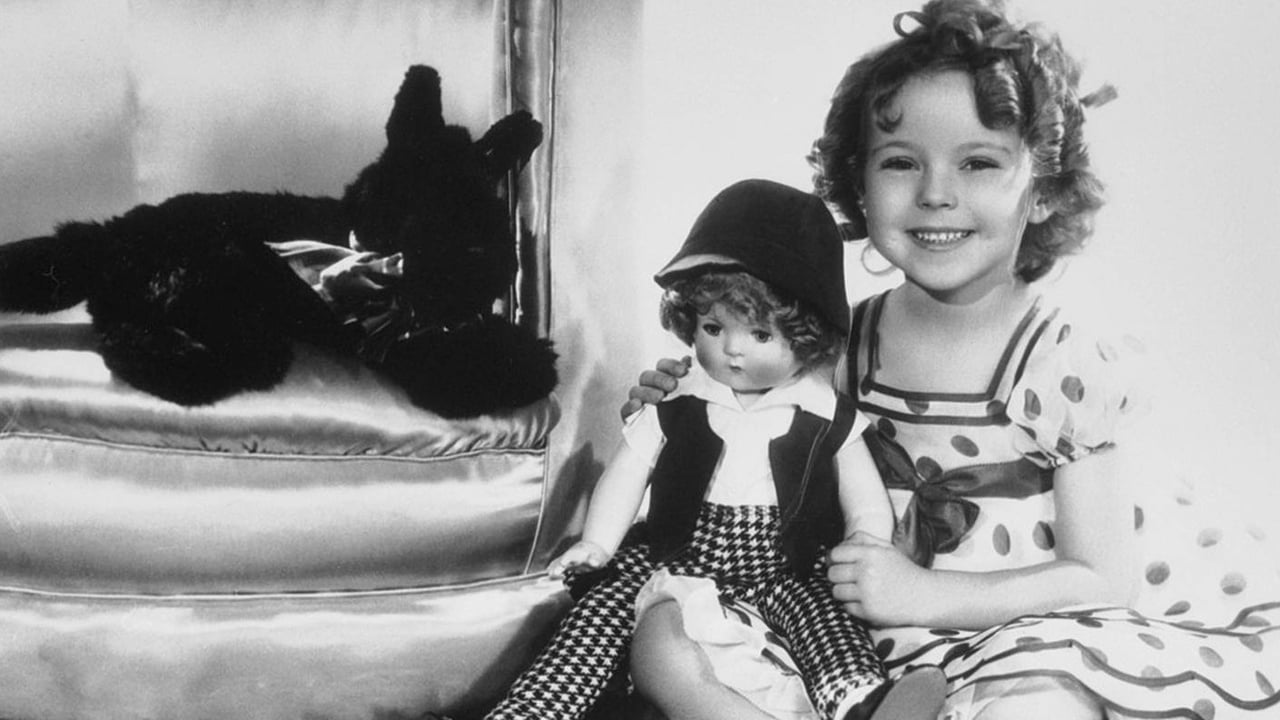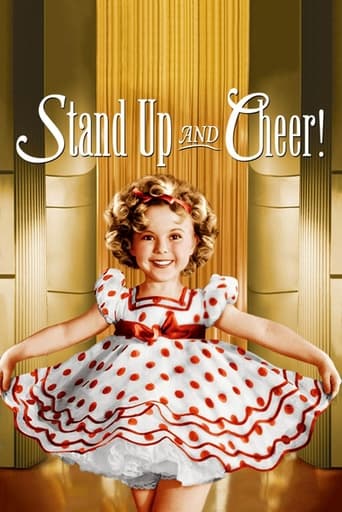

"Stand Up and Cheer" exists in two different TV versions. The first runs 70 minutes, the second around 75. Reviews of both versions follow. By the way, this Lew Brown who figures so prominently in the credits of both versions is the Lew Brown of the De Sylva, Brown and Henderson songwriting team — the subject of the 1956 screen biography, "The Best Things In Life Are Free" in which Brown was portrayed by Ernest Borgnine."Stand Up and Cheer" has some lively production numbers (the marching climax with all the hordes of extras — and the exceptionally skilled film editing that makes it seem there are even more people than there actually are — and Dick Foran singing "Out of the Red" as he charges across the skyline to a geographical musical medley; the elaborate "Hillbilly on Broadway" number with its troupe of dancing, rope-swirling chorus cuties and its dazzling special effects; Shirley Temple and James Dunn in the "Baby Take a Bow" number) interspersed with some rather corny and not particularly funny old vaudeville routines — Stepin Fetchit and "Skins" Miller are two of the biggest liabilities here as the sketches to which they contribute (particularly the talking penguin sketch which is also in rather bad taste with the penguin swallowing live fish from a display aquarium; Miller's hillbilly number is slightly redeemed by his producing an odd and varied assortment of hats — it's an old gag but I'm a sucker for gags with hats) are among the least entertaining. Two acrobats Mitchell and Durant also tend to out-stay their welcome. What makes these numbers even duller is the routine way in which they are handled — quite a contrast with the way the rest of the film is directed with its jostling crowds, fast tracking shots and rapid- fire dialogue delivery and its sharply-cut musical production numbers. There's a good idea back of the script, but despite the enthusiasm of the cast, the dialogue lets the players down as it is not particularly funny, nor satirical, nor sharp, nor witty. The photography by Ernest Palmer and L. W. O'Connell makes the film nearly always attractive to look at (Miss Evans benefits and has some lovely close-ups) and the film comes across well on TV even in what is obviously a dupe from a worn (there are quite a few jump cuts especially in the first half- hour but fortunately few scratches; but alas, most of the cuts are in Miss Temple's "Baby Take a Bow" number) projection print. This TV print is missing some 10 minutes including "I'm Laughing" with "Aunt Jemima". Miss Temple does not have all that much business, and all John Boles does is to sing rather indifferently a rather indifferent love duet. Ralph Morgan has but a tiny bit as the President's (only the back of the presidential head is seen in shadow) secretary. Dick Foran does not come on until the climax. Besides "Out of the Red", he sings the title tune under the end credits.SECOND VIEW: The current television print is also a dupe, but of better quality. It is now possible to judge that O'Connell photographed the dialogue scenes in his usual grainy style, while Palmer handled most of the musical numbers with their higher contrast and velvety blacks. It's pleasing there are no scratches or jump cuts, just one or two slight bloops in the sound track — which is otherwise superb, doing full justice to that great Fox sound.This print includes the elaborate "I'm Laughing" production number, but omits Miller's hillbilly sketch with the hats. Unfortunately, two similar monologues with Fetchit remain, including the tasteless (if cleverly dialogued) Durante penguin episode. Still no "She's 'Way Up Thar".Madge Evans is a charming heroine and has some delightful moments in her early scenes with Warner Baxter's self-proclaimed Authority on Feminine Beauty. The chorus girls are colorfully costumed and Sammy Lee has choreographed their dancing in a lively, inventive manner, accompanied by an orchestra that swings the arrangements in a delightfully jazzy tempo. As for Miss Temple, she is of course an absolute knock-out. Her skill and charm, her sparkling tap-dance with James Dunn, brought down the house wherever the picture played. Although it was not, oddly enough, one of the big box- office successes of the year, Stand Up and Cheer well and truly launched a six-year-old from Santa Monica (California) into the Hollywood big-time.
... View MoreAs you have probably guessed by now, Shirley Temple is the shining light in this rather hum-drum musical comedy. Composer, songwriter, producer Jay Gorney was ecstatic with his prized find, after auditioning close to 150 little girls for this picture. Shirley Temple was exactly what was needed to add some sparkle. As she was rushed into the production, the studio decided to save time, by having Shirley Temple teach James Dunn the dance routines she already knew, rather than teaching her something different. For the next five working days, she and Dunn rehearsed their routine between the few non-musical scenes she had to do. Finally, after lunch one day they were ready to film her song and dance with Dunn. Upon leaving the studio commissary with her mother, an excited Shirley skipped down the stairs, and slipped, falling head first onto the red-brick paving. A small cut on her forehead began oozing blood, a cold compress was immediately applied, but the lump grew larger as the ice melted. Filming was due to start, in desperation Mrs. Temple pulled one of her loose curls across the bump and plastered it down as a spit curl. It did the job, and after that it would always be fifty-six curls and one spit curl. "Stand Up And Cheer" was the big break Mrs.Temple had been waiting for and Shirley Temple was now on her way to becoming the biggest child star of all times.
... View MoreI just watched this movie again, and I think it is wonderful. Shirley Temple is adorable, as always. Madge Evans is terrific. She was way underrated as an actress. She was so good in so many films; Dinner at Eight , Beauty For Sale, and Mayor of Hell are a few that come to mind. Warner Baxter is good, but his role does not offer him the acting opportunity that 42nd Street did , one year earlier.As for Stepin Fetchit, he is marvelous!!! The man was a comic genius. I rate him as good as Stan Laurel. People nowadays keep stressing the stereotypes of minorities in old films. That's true, but even so, actors like Fetchit displayed great talent. And didn't most comedians, of any color, play stereotypical roles? Silliness has always been a source of comedy, whether it was performed by Stepin Fetchit, Stan Laurel, Cary Grant, or Willie Fung. I love the musical numbers! They are upbeat, and happy. my favorite one is not Baby, Take A Bow, but Broadway's Gone Hillbilly. I think that The Picken Sisters sing in this number, although they are not listed in the cast.
... View MoreSTAND UP AND CHEER (Fox, 1934), directed by Hamilton MacFadden, features Warner Baxter as Lawrence Cromwell, a Broadway producer who is appointed by the U.S. president as secretary of amusement to rid the country of the Depression blues. Madge Evans co-stars as Cromwell's secretary, Mary Adams, and Arthur Byron as John Hartly, a corrupt politician who wants to keep the Depression going so he can stay in political power, but fails in trying to bribe Cromwell to give up his position. An enjoyable Depression musical which reflects upon the people and the times, is noted virtually as a Shirley Temple movie. With Baxter and Evans enjoying more screen time, Temple, with her limitations to the plot, became an overnight sensation playing little Shirley Dugan, daughter to song and dance man, Jimmy Dugan (James Dunn). The musical numbers in STAND UP AND CHEER do not play for the audiences in the movie (there are none), but mainly to its viewers. The song and dance appears during the course of the story, beginning with Dick (billed Nick) Foran coming out of a front page newspaper as Baxter and Evans read the headlines, and singing "I'm Laughing," later sung by a cross-country of citizens, and concluding with Aunt Jemima (Tess Gardella) and chorus. Next comes "Baby, Take a Bow" performed by Dunn, a chorine, and Temple; "Broadway's Gone Hillbilly" (sung by Sylvia Froos and chorus); "She's Way Up Thar" (sung by John "Skins" Miller); "This Is Our Last Night Together" (an audition number, sung by John Boles and Sylvia Froos); and the big parade march of happy Americans singing "We're Out of the Red" (introduced by Foran as the Paul Revere bearer of good news on a horse riding across the sky). As many classic movies in recent years have been nearly restored to its original length, such as the 1933 classic, KING KONG, for example, STAND UP AND CHEER seems to have never played in its entirety on television since the 1960s, and currently is the victim of further butchery. While the Stepin Fetchit segment, in which he encounters a penguin dressed, acting and talking like Jimmy Durante, has been restored, other scenes have been deleted, making the print in circulation since 1984 choppy and confusing. There's one scene in the story in which Baxter says "No" to Fetchit before hearing what he has to say. The violent gags of comedy team of Mitchell and Durant as U.S. senators are either trimmed or completely cut out. I was fortunate to have watched the complete version of STAND UP AND CHEER at a revival theater in New York City in the 1980s. Scenes missing from current prints are Aunt Jemima's introduction to "I'm Laughing," and Nick Foran's introduction to the finale, "We're Out of the Red." 'Skins' Miller, billed as the hillbilly, seen looking for a gal named Sally, bursting into song, "She's Way Up Thar," while Fetchit is out in the mountains with a butterfly net hired to get a hillbilly by Dinwiddie (Nigel Bruce), is completely gone. The closing cast credits is shown on screen in freeze frame and ends abruptly. Originally presented in theaters at 80 minutes, it can now be seen on video cassette (sometimes colorized) and on TV at the 69 minute length. A pity, because those seeing this for the first time today will think this is how it was presented to 1934 audiences, and it wasn't. STAND UP AND CHEER, which formerly played on American Movie Classics from 1996 to 2001, can be seen once in a while on the Fox Movie Channel. While no great masterpiece, this is one movie that deserves restoration to its original 80 minute length to be fully appreciated. (**1/2)
... View More